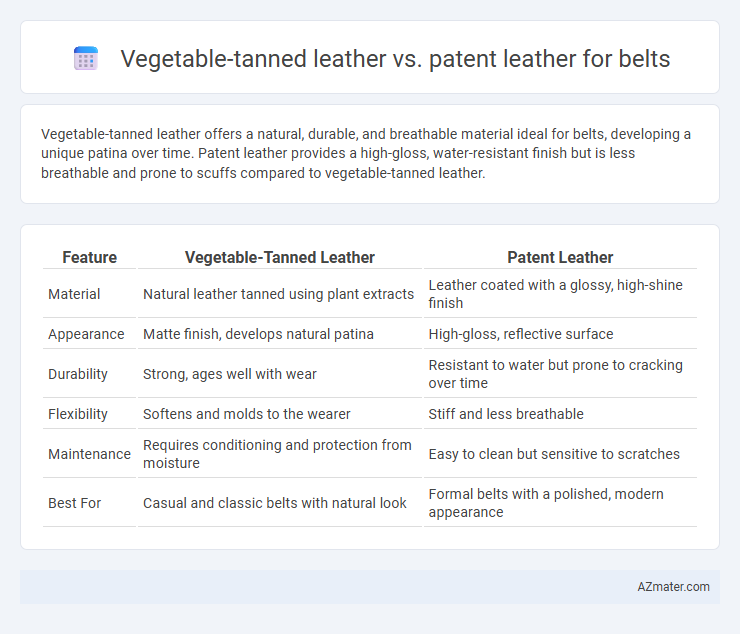Vegetable-tanned leather offers a natural, durable, and breathable material ideal for belts, developing a unique patina over time. Patent leather provides a high-gloss, water-resistant finish but is less breathable and prone to scuffs compared to vegetable-tanned leather.
Table of Comparison
| Feature | Vegetable-Tanned Leather | Patent Leather |
|---|---|---|
| Material | Natural leather tanned using plant extracts | Leather coated with a glossy, high-shine finish |
| Appearance | Matte finish, develops natural patina | High-gloss, reflective surface |
| Durability | Strong, ages well with wear | Resistant to water but prone to cracking over time |
| Flexibility | Softens and molds to the wearer | Stiff and less breathable |
| Maintenance | Requires conditioning and protection from moisture | Easy to clean but sensitive to scratches |
| Best For | Casual and classic belts with natural look | Formal belts with a polished, modern appearance |
Introduction to Vegetable-Tanned and Patent Leather
Vegetable-tanned leather is crafted using natural tannins from tree bark and plants, resulting in a durable, breathable material that develops a rich patina over time, ideal for high-quality belts. Patent leather features a glossy, shiny finish achieved by applying a lacquer or varnish coating, offering a sleek and formal appearance often favored in dress belts. Both types provide distinctive aesthetics and properties, catering to different styles and functional needs in belt design.
What is Vegetable-Tanned Leather?
Vegetable-tanned leather is crafted using natural tannins extracted from tree bark, leaves, and other plant sources, resulting in a durable and eco-friendly material that develops a unique patina over time. Unlike patent leather, which has a glossy, synthetic coating, vegetable-tanned leather maintains a matte finish and offers greater breathability and flexibility for belts. This traditional tanning process enhances the leather's strength and natural aesthetic, making it a preferred choice for those seeking long-lasting, handcrafted accessories.
What is Patent Leather?
Patent leather is a type of leather coated with a high-gloss, shiny finish achieved through a layer of lacquer or synthetic polymer. This coating provides a smooth, reflective surface that is water-resistant and easy to clean but lacks the natural breathability and flexibility of vegetable-tanned leather. Unlike vegetable-tanned leather, which develops a patina over time, patent leather maintains its polished look without darkening or softening.
Durability Comparison: Vegetable-Tanned vs Patent Leather
Vegetable-tanned leather offers superior durability for belts due to its natural aging process, developing a patina that enhances strength over time. Patent leather, coated with a glossy finish, tends to be less durable as the surface is prone to cracking and peeling with prolonged use. In demanding daily wear, vegetable-tanned belts maintain structural integrity far better than patent leather alternatives.
Appearance and Aesthetic Differences
Vegetable-tanned leather belts showcase a natural, matte finish with rich, earthy tones that deepen over time, providing a classic and organic aesthetic. Patent leather belts feature a glossy, highly reflective surface that offers a sleek, polished look ideal for formal or fashion-forward styles. The contrast between the subtle texture of vegetable-tanned leather and the mirror-like sheen of patent leather defines distinct visual appeals suitable for different wardrobe choices.
Comfort and Flexibility
Vegetable-tanned leather offers superior comfort and flexibility for belts due to its natural tanning process, which allows the leather to mold to the wearer's body over time. Unlike patent leather, which is coated with a glossy finish that can feel stiff and less breathable, vegetable-tanned leather remains soft and supple, enhancing long-term wearability. This makes vegetable-tanned belts ideal for all-day comfort and adaptability to various waist sizes.
Environmental Impact and Sustainability
Vegetable-tanned leather uses natural tannins from plant sources, making it biodegradable and less harmful to the environment compared to patent leather, which relies on synthetic coatings derived from petrochemicals and often involves toxic chemicals during production. The sustainable tanning process reduces water pollution and energy consumption, whereas patent leather's manufacturing contributes to higher carbon footprints and landfill waste due to its non-biodegradable finishes. Choosing vegetable-tanned belts supports eco-friendly practices and promotes a lower environmental impact across the leather goods industry.
Maintenance and Care Requirements
Vegetable-tanned leather belts require regular conditioning with natural oils or waxes to maintain suppleness and prevent drying or cracking, and they should be kept away from prolonged moisture exposure. Patent leather belts demand minimal maintenance, needing only occasional wiping with a damp cloth to preserve their glossy finish and avoid dulling or scuff marks. Proper storage in a cool, dry place is essential for both types to extend belt longevity and appearance.
Price and Market Availability
Vegetable-tanned leather belts typically cost between $50 and $150, reflecting their natural tanning process and durability, while patent leather belts are generally priced lower, ranging from $30 to $100 due to their synthetic glossy finish. Market availability for vegetable-tanned leather belts is more common in high-end and artisan stores, emphasizing quality and sustainability, whereas patent leather belts are widely available in mass-market retailers and fashion outlets. The price difference and accessibility largely stem from production methods and target consumer preferences in the belt market.
Choosing the Best Leather Type for Your Belt
Vegetable-tanned leather offers durability, a natural finish, and develops a unique patina over time, making it ideal for belts requiring long-lasting quality and character. Patent leather provides a glossy, polished appearance that suits formal occasions but may be less breathable and prone to scuff marks. Selecting the best leather type for your belt depends on the balance between aesthetic preferences, durability needs, and maintenance requirements.

Infographic: Vegetable-tanned leather vs Patent leather for Belt
 azmater.com
azmater.com